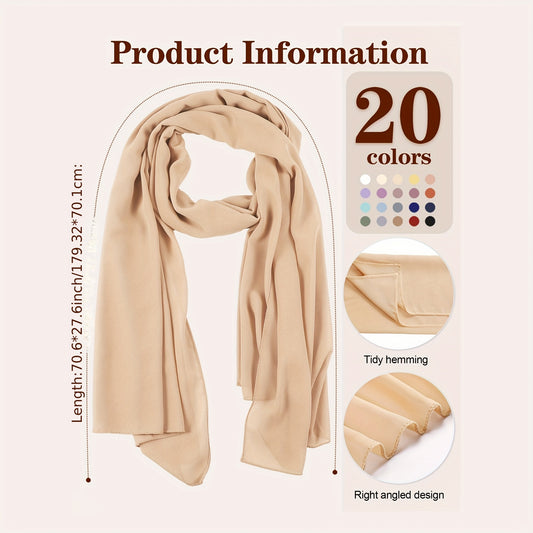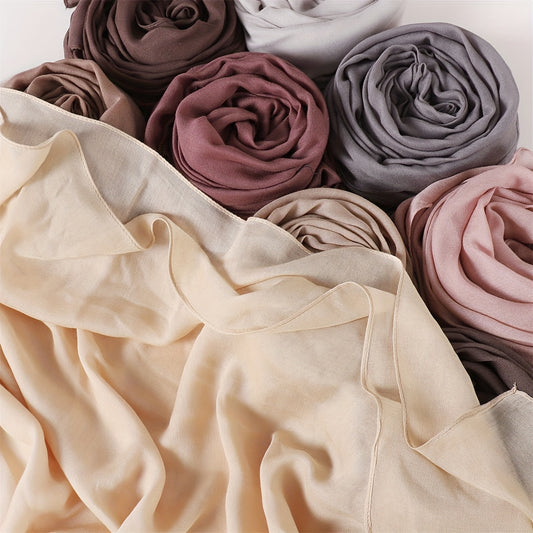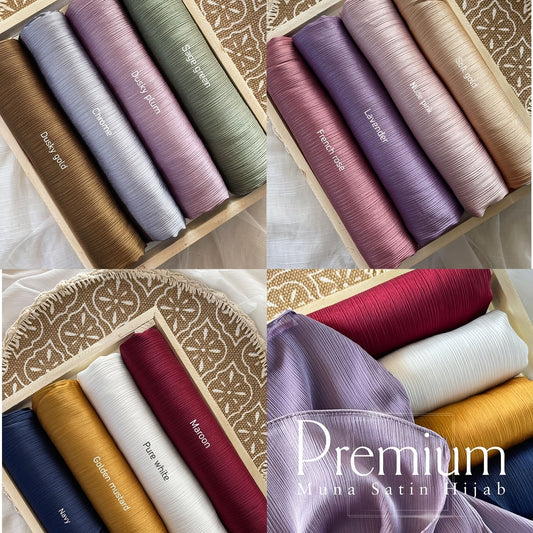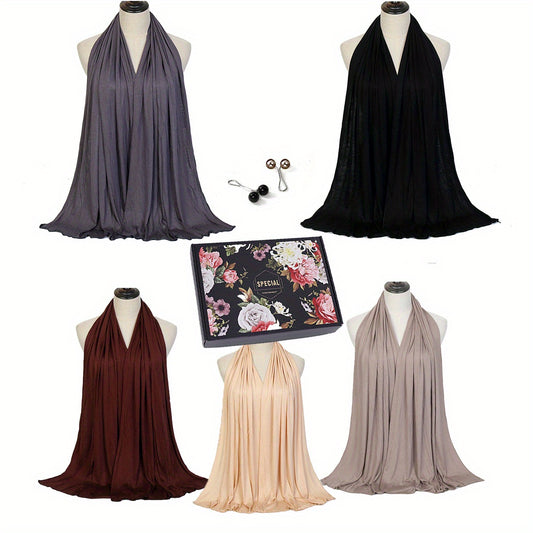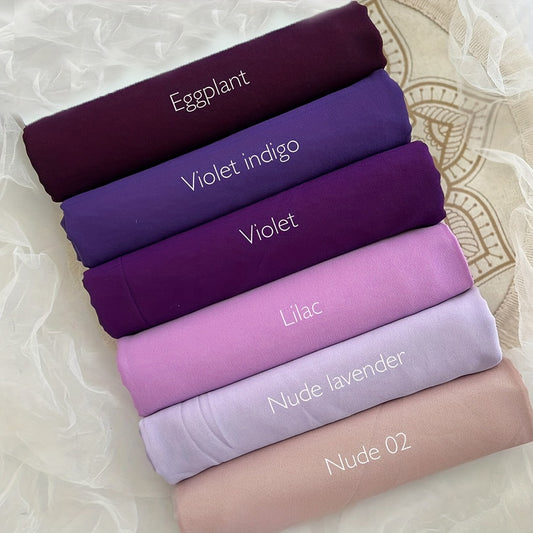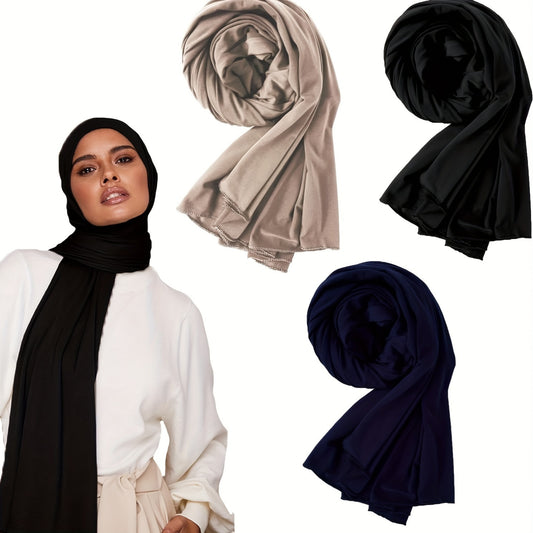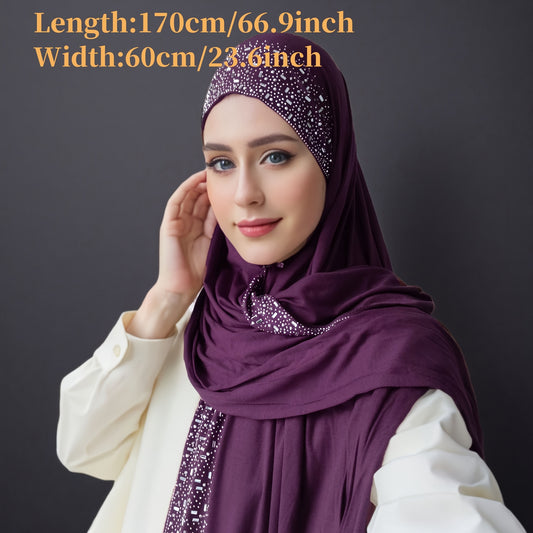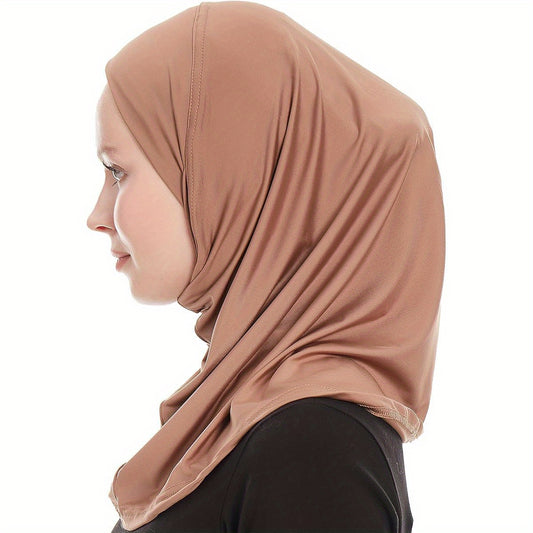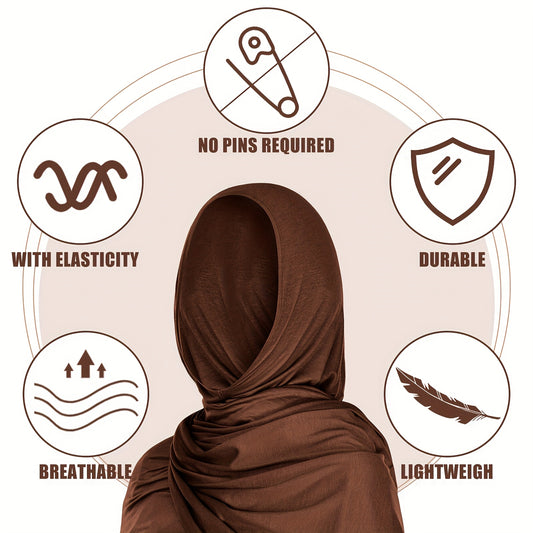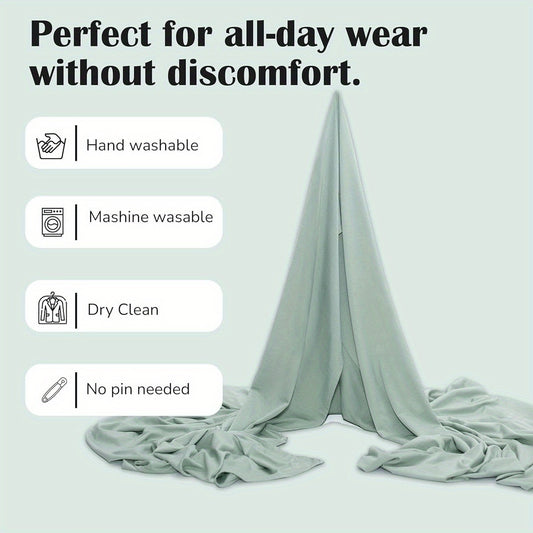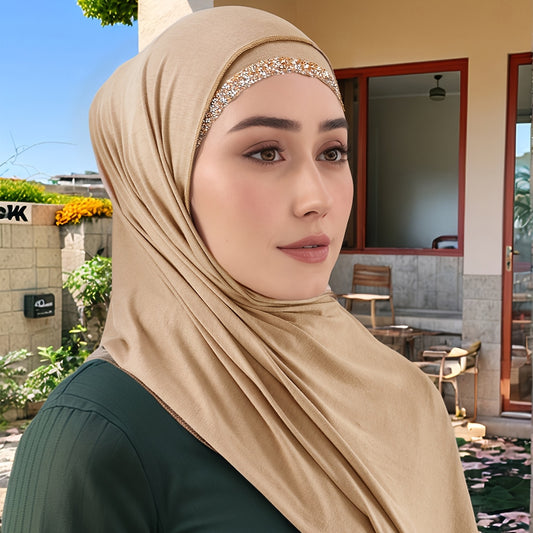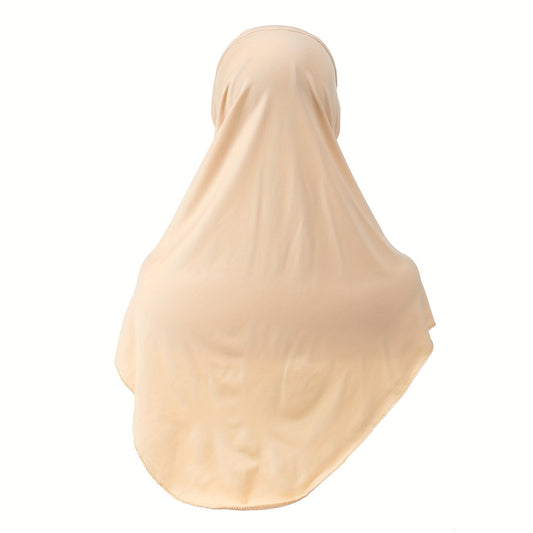The Complete Guide To Hijabs
Origins, Essence, And Cultural Significance
Introduction To The Hijab As A Luxury Essential
The hijab is one of the most iconic garments in the global fashion vocabulary—at once spiritual, cultural, and sartorial. Defined by its simple premise of draping fabric around the head and shoulders, the hijab transcends modesty into a symbol of identity and elegance. While its roots are deeply embedded in faith and tradition, the modern hijab has expanded into the realm of luxury lifestyle, offering women the ability to express values while celebrating personal style.
In contemporary wardrobes, the hijab is no longer confined to one interpretation. It exists as chiffon veils for weddings, breathable cottons for everyday wear, satin-silk scarves for evening polish, and printed styles that complement global fashion trends. This adaptability reflects why the hijab has retained relevance across centuries: it is both spiritual armor and aesthetic choice, offering coverage without denying individuality.
Fabulive has recognized the hijab’s enduring resonance and curated collections that marry modesty with modern luxury. Each piece embodies integrity of material, design precision, and seasonless elegance, proving that modest fashion can be as sophisticated and versatile as any other domain of style.
The Genealogy Of The Hijab
The hijab’s genealogy traces back through cultures where veiling garments symbolized respect, privacy, or ceremonial dignity. In ancient Mesopotamia, Assyrian women of noble birth wore veils as markers of class distinction. Across the Mediterranean and Middle Eastern regions, veiling practices emerged in both religious and social contexts. Over centuries, the hijab evolved into an Islamic cultural mainstay, taking on layers of meaning—spiritual, cultural, and personal.
Regional differences enriched its vocabulary:
-
Middle East: Sheer georgettes and silks embroidered with metallic threads emphasized elegance for formal settings.
-
South Asia: Cotton hijabs adorned with gota trims or resham embroidery merged modesty with artisanal craft.
-
North Africa: Heavier woven hijabs in indigo or striped textiles offered both coverage and cultural symbolism.
-
Modern Global Fashion: Lightweight chiffons, stretch jerseys, and digitally printed silks enabled hijabs to function as contemporary style statements.
This historical layering ensures that the hijab is not merely clothing but a cultural tapestry woven through centuries of practice.
The Hijab As A Modern Fashion Icon
In the 20th and 21st centuries, the hijab transformed into a global fashion icon. International designers introduced it into runway shows, while modest fashion brands developed expansive collections catering to Muslim women seeking style alongside faith. Hijabi influencers on digital platforms reinforced its relevance, proving that the hijab can sit comfortably in high-fashion editorials, red-carpet appearances, and everyday streetwear alike.
For many women, the hijab symbolizes empowerment rather than restriction. It becomes an intentional statement: choosing modesty while embracing luxury, choosing cultural continuity while celebrating individuality. Fabulive captures this sentiment, ensuring its hijabs speak to women who want garments that perform across prayer, celebration, travel, and everyday life.
Defining The Hijab’s Aesthetic Codes
The hijab is deceptively simple—just a length of fabric. Yet, within this simplicity lies infinite variation. The design codes revolve around three essential elements:
-
Proportion: Hijabs differ in size and cut, influencing drape. Narrower scarves create sleek silhouettes; larger squares or rectangles offer volume for layering.
-
Drape: The way a hijab falls is determined by fabric weight, weave, and finish. Silk slips into fluid folds; cotton holds structure; chiffon floats with translucency.
-
Finish: Rolled hems, hand-sewn edges, laser-cut trims, and embellishments elevate or simplify the overall mood.
When these three codes are balanced, the hijab moves beyond utility into artistry.
Cultural Resonance In Daily Life
The hijab occupies a central place in cultural expression. It is worn during daily prayers, academic settings, professional spaces, weddings, and global travel. Its versatility is unmatched. For example:
-
A matte jersey hijab anchors professional authority in workplaces.
-
A silk-satin hijab elevates bridal attire into regal territory.
-
A printed chiffon hijab energizes casual weekend dressing.
-
A breathable cotton hijab sustains comfort in hot, humid climates.
By mediating space between body, fabric, and gaze, the hijab becomes a daily negotiation of values—personal, social, and aesthetic.
The Hijab As Emotional And Social Identity
Wearing a hijab is often described by women as a deeply personal journey. For some, it represents alignment with spiritual principles; for others, it affirms belonging to a cultural community. Beyond symbolism, it also becomes a source of emotional ease. The act of draping a hijab each morning signals intentionality: starting the day with values embodied in cloth.
In multicultural contexts, the hijab also sparks dialogue. It is simultaneously a marker of difference and a bridge of connection. By existing in both sacred and secular spaces, it offers women a unique ability to balance faith with fashion, privacy with presence.
Why The Hijab Endures Across Generations
The endurance of the hijab can be explained through six dimensions:
-
Spiritual Continuity: It remains rooted in religious tradition, offering timeless meaning.
-
Cultural Elasticity: It adapts across geographies, absorbing regional crafts and aesthetics.
-
Functional Versatility: A single piece can serve daily, ceremonial, or professional purposes.
-
Fashion Longevity: It resists trend obsolescence; classic black chiffon hijabs look as relevant today as they did decades ago.
-
Inclusivity: Available in fabrics, colors, and cuts for all ages, body types, and climates.
-
Personal Agency: Women choose how to wear, drape, or style it, shaping identity on their terms.
These qualities ensure the hijab is not merely an accessory but a permanent chapter in the story of fashion.
Fabulive’s Place In The Modern Hijab Market
Within this global landscape, Fabulive positions itself as a curator of elegance and responsibility. Unlike mass-market hijabs that compromise fabric quality, Fabulive emphasizes:
-
Luxury Fabrics: From silk chiffons to matte georgettes that breathe in tropical climates.
-
Responsible Craft: Prioritizing dyes and finishes that reduce environmental impact.
-
Design Refinement: Rolled hems, invisible stitching, and clean finishes elevate simplicity.
-
Timeless Palettes: Jewel tones for ceremony, neutrals for professionalism, prints for everyday rotation.
-
Customer Accessibility: Clear sizing guides, easy online ordering, and versatile styling options.
Fabulive’s hijabs prove that modest fashion does not need to choose between responsibility and beauty. Instead, it delivers both.
Design Principles, Silhouettes, And Materials
The Architecture Of A Hijab
At first glance, the hijab is simply a square or rectangular piece of fabric. Yet its elegance lies in how proportion, cut, and finish interact to create a garment that balances modesty with sophistication. Just as a kaftan is defined by architectural thinking, so too the hijab depends on principles of geometry and flow.
Designers consider three structural elements:
-
Proportion: Size determines how much coverage is possible and what styles of drape can be achieved. Smaller scarves offer sleek, minimalist wraps, while oversized shawls invite layered styling.
-
Line: Straight edges, bias cuts, or rounded corners influence how the hijab falls. Clean lines create precision; rounded ones soften the silhouette.
-
Balance: The weight of fabric relative to its size must allow natural drape. Too heavy, and folds collapse; too light, and the hijab loses structure.
When these principles align, the hijab transforms from simple fabric into an intentional accessory capable of expressing identity and taste.
Core Hijab Silhouette Families
The Square
The traditional square hijab, folded into a triangle and wrapped, is iconic in many cultures. It frames the face symmetrically and offers balanced coverage. Square hijabs are particularly suited for cotton voile, georgette, or crepe fabrics that hold shape.
The Rectangle (Shayla)
Rectangular hijabs, often called shaylas, allow versatile styling: wrapped loosely around the neck for casual settings or layered tightly for secure coverage. Their elongated proportions suit chiffons and jerseys that flow smoothly without bulk.
The Oversized Scarf
Popular in modern modest fashion, oversized scarves can be styled dramatically with cascading folds. They lend themselves to luxurious fabrics like silk chiffon or modal blends. This silhouette resonates with women who favor bold styling, offering both volume and presence.
Instant And Pre-Stitched Hijabs
Responding to busy lifestyles, designers now offer pre-sewn hijabs that slip on in seconds. Though structurally simple, the quality of fabric and finish determines whether they appear refined or utilitarian. Luxury versions use matte jersey or crepe blends to maintain elegance.
Each silhouette family speaks to a different lifestyle need—whether ceremonial formality, everyday ease, or travel practicality.
The Science Of Fabrics In Hijabs
Fabric determines not only drape but also breathability, climate adaptability, and longevity. The modern luxury hijab relies on a refined vocabulary of textiles:
-
Silk Chiffon: Ethereal, sheer, and fluid. Perfect for weddings or evening events. It photographs beautifully, catching light with elegance.
-
Silk Satin: Smooth, glossy, and opulent. Satin hijabs offer richness for black-tie events but require careful pinning to avoid slipping.
-
Cotton Voile: Lightweight, crisp, and breathable. Ideal for hot climates and everyday wear. Holds shape well and launders easily.
-
Linen Blends: Cool and textured, offering a natural matte finish. Favored in resort or summer capsules.
-
Georgette: Matte with slight grit, ensuring grip and structure. A favorite for professional contexts where polish matters.
-
Modal And Viscose: Soft, sustainable, and breathable. These fibers wick moisture and resist wrinkles, making them travel-friendly.
-
Jersey (Cotton Or Modal): Stretchy and forgiving, jersey hijabs require no pins and suit active lifestyles.
-
Velvet Or Devoré: Luxurious winter options that add depth and richness for ceremonies.
Each fabric responds differently to light, climate, and handling. Choosing the right one ensures the hijab performs both aesthetically and practically.
Drape, Weight, And Handle
Luxury hijab design depends on subtle textile science:
-
Drape: How the fabric falls over contours. Silk chiffon drapes in liquid folds; cotton voile maintains angular precision.
-
Weight: Measured in grams per square meter (GSM). Lightweight fabrics float; heavier ones provide structured volume.
-
Handle: The tactile quality—smooth, gritty, springy, or dry. Handle influences comfort as much as drape.
Designers calibrate these variables carefully. A slightly heavier crepe adds authority in professional settings; an airy voile creates cloudlike ease on summer days.
Surface Finishes And Detailing
Hem Finishes
-
Rolled Hems: Hand-rolled for invisible delicacy in silks.
-
Top-Stitched Hems: Provide durability in cotton and jersey.
-
Laser-Cut Edges: Modern, sharp, often used in technical fabrics.
Embellishments
-
Embroidery: Resham threads, metallic stitches, or Moroccan sfifa trims.
-
Beadwork: Applied sparingly at borders for ceremonial hijabs.
-
Crystals And Sequins: Evening hijabs may include Swarovski or subtle bead accents for light-catching sparkle.
-
Digital Printing: Allows crisp artwork and reduces dye waste, creating statement hijabs with engineered motifs.
When ornament is added, it must stabilize rather than weigh down the cloth. Placement at hems, edges, or corners ensures elegance without distortion.
Minimalism Versus Maximalism In Hijab Design
Luxury hijabs exist in two dialects:
-
Minimalist: Solid matte georgette in neutral palettes, designed for offices or everyday professionalism. Their elegance lies in restraint.
-
Maximalist: Bold prints, metallic embroidery, or saturated jewel tones for weddings and celebrations. These hijabs make the garment itself the centerpiece.
Both have their place in refined wardrobes. Fabulive’s curation respects this polarity, ensuring clients can select pieces for both quiet sophistication and expressive glamour.
Color Strategies And Seasonal Palettes
Color transforms the hijab from simple covering into intentional styling.
-
Jewel Tones: Emerald, sapphire, and ruby exude ceremony.
-
Earth Neutrals: Sand, taupe, and olive ground daytime looks.
-
Seaside Palettes: Aqua, coral, and shell shades for resort capsules.
-
Monochrome Black Or White: Sculptural and timeless, always relevant for photography.
Designers also exploit ombré fades, engineered borders, and geometric motifs. Strategic color placement elongates frames, softens features, or directs the gaze.
Fabulive’s Emphasis On Design Integrity
Fabulive distinguishes itself by prioritizing detail where others cut corners. Customers can expect:
-
Clean Hemlines: No loose threads, ensuring hijabs look elegant even under close inspection.
-
Engineered Prints: Patterns aligned at edges rather than cut haphazardly.
-
Balanced Proportions: Sizes designed for practical draping without excess bulk.
-
Luxury Fabrics: Focus on silks, modal blends, and breathable cottons that endure repeated wear.
By curating hijabs through this lens, Fabulive transforms what many view as a basic garment into an enduring luxury piece.
Functionality, Performance, And Regional Variations
The Hidden Engineering Of Effortlessness
The hijab’s elegance is inseparable from its engineering. While it appears to be a simple length of fabric, its refinement comes from subtle design intelligence. Every detail—from hem finish to fabric grip—is calculated to ensure that the hijab stays in place, moves comfortably, and looks intentional. Rolled hems in silks prevent fraying while preserving lightness, while top-stitched hems in cotton resist wear from daily washing. Grip is equally important: matte georgette and crepe fabrics naturally resist slipping, creating security without excess pins, while satin or chiffon require undercaps or discreet magnetic pins to anchor gracefully. Pre-sewn hijabs, designed for convenience, succeed only if crafted from high-quality stretch fibers that retain elasticity and elegance after repeated use. In luxury design, engineering is invisible but indispensable, ensuring that the hijab does not distract the wearer with adjustments but instead empowers her presence.
Climate Performance And Daily Utility
Functionality is amplified when fabric meets climate. In tropical humidity, cotton voile and viscose wick moisture, ensuring breathability for long hours. In desert heat, linen blends disperse warmth, with pale colors reflecting sunlight and preventing overheating. For temperate urban settings, matte crepe or modal offers resilience across indoor and outdoor transitions, holding shape throughout a day that spans office, commute, and evening obligations. Winter calls for velvet or wool gauze hijabs that insulate while maintaining elegant drape. Designers manipulate weave density to adapt performance: open weaves promote airflow, tight weaves block cold winds. Frequent travelers gravitate toward wrinkle-resistant fabrics such as modal, Tencel, or treated crepes, which emerge from luggage crease-free and revive with light steaming. A hijab that performs in climate and lifestyle contexts is one that earns repeated use, delivering long-term value.
Lifestyle Integration
The modern hijab must perform across roles—professional, academic, maternal, celebratory, and travel-related. In offices, georgette and crepe hijabs project polish, pairing with tailored blazers to deliver authority without compromising modesty. Students prefer cotton or jersey hijabs that combine breathability with easy care for long days on campus. Mothers balancing work and family reach for fabrics that launder quickly, dry fast, and withstand repeated handling. Travelers value oversized scarves that double as wraps, blankets, or makeshift shawls on flights. Brides, in contrast, demand silk or satin hijabs engineered to photograph beautifully under strong lighting, often with subtle embroidery at the edges. Functionality is not about limiting the hijab to one identity but expanding it into every role a woman embodies.
Regional Interpretations And Variations
The hijab is a global garment whose vocabulary shifts across geographies. In the Middle East, chiffon and crepe shaylas dominate daily wear, styled in neutral palettes for office life and jewel tones embellished with crystals for weddings. South Asia contributes hijabs with artisanal craft—ajrak block prints, resham embroidery, and gota trims—integrating centuries-old textile traditions into modern modest fashion. In Pakistan, lightweight chiffon hijabs with beadwork serve festive occasions, while India’s zari-bordered silks carry ceremonial weight. North Africa embraces woven cotton hijabs in stripes or indigo tones, textures suited to desert evenings, with Moroccan sfifa trims adding luxury definition. East Africa introduces brightly patterned kangas and wraps, where color is language and pattern is communal identity. Turkey’s Ottoman heritage remains visible in striped silks and ikats, though modern Turkish urban fashion now favors matte crepes and tailored scarves. Iran’s chador remains a traditional full-coverage form, but contemporary Iranian women also wear tailored silk or cotton scarves that integrate with professional attire. In Europe and North America, hijabs blend seamlessly with mainstream wardrobes: neutral matte georgettes styled with structured coats, printed chiffons paired with denim, and satin scarves incorporated into evening wear. Each region preserves its voice, creating a cultural symphony of modest fashion.
Motif Symbolism And Cultural Depth
The hijab is also a canvas for motifs that carry cultural meaning. Persian floral gardens embroidered onto silks evoke paradise and poetic imagery, while Levantine geometric borders symbolize protection and order. Ajrak block prints from Sindh embed mathematical geometry into fabric, carrying centuries of artisanal knowledge. African wax prints tell communal stories, their bold colors signaling identity in ways that words cannot. Luxury hijabs engage with these motifs respectfully, ensuring that cultural traditions are cited and sustained rather than diluted. For global clients, owning such pieces is both a fashion statement and an act of cultural appreciation.
Innovation Meets Tradition
Contemporary hijab design increasingly integrates technical solutions without undermining heritage. Breathable mesh undercaps prevent overheating during long wear. Magnetic pins replace sharp needles, protecting delicate fabrics while saving time. Wrinkle-resistant treatments ensure fabrics maintain crispness through long commutes or travel. Some hijabs now include subtle pre-stitched folds for consistent draping. These innovations recognize that today’s hijabi woman balances tradition with a fast-paced lifestyle, and her clothing must rise to meet that reality. Performance is therefore both practical and symbolic—it respects faith while embracing modern convenience.
Photography, Lighting, And Event Presence
Luxury hijabs are chosen not only for physical wear but also for how they photograph. Brides test fabrics under LED and flash photography to confirm sheen and opacity. Matte finishes such as georgette avoid glare, while satin requires careful lighting to prevent over-shine. Engineered prints frame the face in portraits, ensuring symmetry that reads as intentional in photography. Stage lighting for graduations or conferences can exaggerate fabric flaws, making finishing details crucial. A hijab that photographs as elegantly as it wears fulfills both memory and presence, capturing milestones with dignity.
Fabulive’s Commitment To Functional Luxury
Fabulive approaches functionality with precision. Every hijab is selected for breathability, drape, and durability. Prints are engineered to frame the face regardless of styling choice. Stitching is reinforced to withstand frequent pinning, while palettes are curated to form capsules rather than scattered pieces. Wrinkle-resistant blends support travelers, while embroidered silks serve brides and celebrants. Each product must solve real lifestyle needs without sacrificing beauty. This approach ensures Fabulive’s hijabs remain companions across prayer, office, travel, and ceremony. Luxury is not decoration—it is problem-solving disguised as elegance.
Styling, Accessory Strategies, And Occasion Capsules
The Hijab As A Styling Framework
The hijab is not merely a garment of modesty; it is also a styling framework that adapts fluidly to context. Its core strength lies in versatility—one silhouette that can be programmed endlessly through fabric, drape, and accessory selection. A matte jersey hijab communicates weekend ease, while a silk chiffon hijab styled with jewelry transforms into a ceremonial statement. Women who understand this framework maximize cost-per-wear, unlocking dozens of looks from a compact collection. This styling adaptability is why the hijab functions as a luxury essential in modern wardrobes.
Everyday Styling Strategies
Styling the hijab for daily life requires balancing practicality with refinement. For professional offices, matte crepe or georgette hijabs in restrained tones such as navy, camel, or charcoal project authority while avoiding distraction. Paired with tailored blazers and minimal jewelry, they integrate seamlessly into global workplace codes. For casual weekends, cotton voile or jersey hijabs provide comfort and breathability. Styled with denim, espadrilles, and woven handbags, they express effortless chic. Students favor easy-care fabrics like modal, which withstand long days and frequent washes. Mothers often gravitate toward wrinkle-resistant viscose blends, which launder quickly while retaining elegance. The underlying strategy remains the same: select fabric and tone that match activity, then accessorize lightly for polish.
Occasion Dressing And Event Logic
Hijabs excel in occasion dressing because they elevate without discomfort. For weddings, silk satin or embroidered chiffon hijabs paired with gowns or kaftans create regal harmony. Brides often select ivory or champagne silks trimmed with crystals that photograph beautifully in both daylight and candlelight. Mothers of the couple favor jewel tones such as emerald, garnet, or sapphire in silk crepe, which balance coverage with gravitas. Guests may choose digitally printed hijabs in floral or geometric motifs to bring individuality without overshadowing the bridal party. For black-tie galas, black silk or velvet hijabs combined with structured gowns read sculptural and timeless. Unlike restrictive hairstyles or elaborate headpieces, hijabs retain comfort through long hours of ceremony.
Travel And Resort Styling
Travel wardrobes demand garments that are light, versatile, and quick to refresh. Oversized viscose or modal hijabs dominate this category, doubling as wraps, shawls, or makeshift blankets on flights. Neutral tones like taupe, sand, and ivory coordinate easily across outfits, minimizing packing. For resort contexts, sheer chiffon hijabs layered over swimsuits or resort kaftans offer coverage while maintaining airflow. Paired with straw hats and leather slides, they embody cosmopolitan ease. Evening dinners in seaside destinations call for silk crepe hijabs in jewel tones, styled with statement earrings and flat metallic sandals for elegance without formality. The travel capsule emphasizes efficiency, proving that three hijabs can serve a full week of holiday dressing.
Accessory Logic For Multiplying Looks
Accessories determine whether a hijab reads minimal, professional, festive, or glamorous. Belts, jewelry, footwear, and bags interact with hijabs to create new codes. A plain black georgette hijab transforms from office to evening with nothing more than crystal drop earrings. Hammered metal cuffs and oversized sunglasses modernize daytime cotton hijabs. For celebrations, jeweled brooches or subtle bead trims amplify elegance without overwhelming the silhouette. Belts paired with long tunics or abayas reprogram hijabs into tailored ensembles. Footwear also carries impact: sneakers paired with a jersey hijab read urban casual, while strappy heels elevate the same fabric into cocktail territory. The logic is modular: change the accessories, reprogram the hijab.
Styling Hijabs For Different Lifestyles
Each lifestyle demands its own hijab strategies. The creative professional requires matte crepes in architectural cuts paired with sculptural jewelry and structured totes. Her hijab capsule relies on restrained colors and versatile fabrics that balance personality with authority. The frequent traveler values modal and wrinkle-resistant viscose hijabs, neutral palettes, and oversized silhouettes that shift from airport lounge to dinner table. The minimalist invests in three to four hijabs: one cotton for daytime, one silk for evening, one viscose for travel, and one ceremonial embroidered chiffon. The celebrant prioritizes jewel-toned silks, sequined chiffons, and richly printed scarves for weddings and festivals. These lifestyle capsules prove that the hijab is not an accessory but a wardrobe system.
Body Diversity And Proportion Styling
The hijab adapts gracefully to different body types, but proportion must be considered. Petite women benefit from lighter fabrics like chiffon or cotton voile that avoid overwhelming the frame, paired with vertical motifs or ombré fades that elongate. Taller figures can lean into oversized modal hijabs or bold prints that highlight stature. Curvier women often favor A-line tunics with matte hijabs, using drape to frame the face while maintaining balanced volume. Face shapes also influence hijab choice: oval faces suit most drapes, round faces benefit from angled folds that create structure, and angular faces are softened by fluid fabrics like chiffon. These strategies ensure inclusivity: the hijab affirms beauty without imposing one standard.
Photography And Public Presence
Styling must anticipate photography, whether for professional headshots, family events, or social media. Matte finishes such as georgette and crepe are favored in offices because they diffuse light evenly under cameras, avoiding shine. Brides test silk or satin hijabs under stage lighting to evaluate how sheen translates in portraits. Engineered prints are often chosen for graduations or milestone photos because they frame the face consistently across angles. Small high-contrast prints are avoided, as they can strobe on video. Luxury styling always considers presence in both real and digital spaces, ensuring memories are captured elegantly.
Fabulive’s Approach To Styling Solutions
Fabulive curates hijabs not as isolated pieces but as systems. Collections are designed to create wardrobe capsules that integrate across lifestyles: neutral georgettes for office, jewel-toned silks for celebration, wrinkle-resistant viscose for travel, and airy cottons for weekends. Customers are encouraged to build intentional palettes—sand neutrals, jewel tones, or monochromes—ensuring hijabs interlock with existing wardrobes. Accessories such as magnetic pins, undercaps, and brooches are curated to extend styling versatility. This approach reflects Fabulive’s promise: the hijab should solve real styling challenges while retaining cultural and spiritual integrity.
Maintenance, Sustainability, And Investment Logic
The Role Of Care In Longevity
A hijab’s elegance is only as enduring as its maintenance. Luxury fabrics demand careful handling to preserve drape, sheen, and integrity. Silk hijabs require dry cleaning or delicate handwashing with silk-safe cleansers, avoiding harsh detergents that strip natural luster. Chiffon and georgette hijabs benefit from gentle handwashing in cool water, followed by rolling in towels to absorb excess moisture before air-drying flat. Cotton voile and viscose hijabs tolerate delicate machine cycles inside mesh bags, but heat must be avoided to preserve fiber elasticity. Velvet or devoré hijabs require specialist cleaning to prevent pile crushing. Ironing technique also defines lifespan: silks and satins must be steamed from the reverse, never pressed directly, while cottons can be lightly ironed for crispness. Proper maintenance ensures fabrics maintain their intended handle and drape, extending wear across seasons.
Storage Strategies For Luxury Hijabs
Storage practices protect hijabs from distortion, fading, and fiber stress. Silks and chiffons should hang on padded hangers to prevent creasing, while cotton and viscose hijabs may be folded neatly in drawers with tissue layers to reduce friction. Embellished hijabs require flat storage in breathable fabric bags to prevent beadwork from snagging. Avoiding sunlight exposure prevents color fade, while climate-controlled storage reduces mildew in humid regions. For travel, rolling hijabs instead of folding minimizes crease lines, and placing them in cloth pouches protects from makeup or perfume stains inside luggage. Clients investing in premium collections often maintain seasonal rotations, storing lightweight hijabs separately from winter-weight velvets or wools to streamline daily access.
Repair, Restoration, And Aftercare
Even the most luxurious hijabs require occasional repair. Loose beads must be re-secured with reinforced stitching, pulled threads re-anchored to seam allowances, and split seams re-stitched to restore integrity. Sun-faded hijabs can be re-dyed in deeper tones, extending their life in a new aesthetic. Small frays at hems can be sealed with fine hand-stitching, preserving elegance without visible disruption. Restoration is especially important for heirloom or ceremonial hijabs, where heritage embroidery or artisanal printing carries sentimental value. By treating these garments as long-term investments rather than disposable accessories, owners extend both material and emotional lifespan.
Sustainability And Fiber Responsibility
Sustainability begins with fiber choice. Organic cotton reduces pesticide use, supporting healthier soil ecosystems. Linen requires minimal irrigation and offers biodegradable afterlife. Modal and Tencel, produced from renewable wood sources, consume less water and deliver superior breathability. Peace silk allows silkworms to complete their life cycle, aligning luxury with ethics. Recycled polyester chiffons divert plastic waste from landfills while delivering resilience. Sustainable dyeing methods, such as low-impact reactive dyes or natural plant-based alternatives, reduce water consumption and chemical runoff. Digital printing minimizes waste by applying pigment only where needed. Packaging also forms part of responsibility: recycled paper wraps, compostable polybags, and minimalist tags reduce environmental footprint. When sustainability is considered holistically, hijabs serve as both garments and statements of ethical alignment.
Traceability And Cultural Responsibility
Traceability is increasingly valued by conscious clients. Knowing where fibers were harvested, where fabrics were woven, and which artisans stitched hems or embroidery creates accountability. Transparent supply chains protect workers while validating product claims. Cultural responsibility extends this further. Hijabs often carry motifs rooted in heritage, from ajrak block prints in Sindh to sfifa trims in Morocco. Brands committed to authenticity credit these traditions, compensating artisans fairly and preventing cultural erasure. Fabulive emphasizes traceability, publishing sourcing stories and maintaining partnerships with craftspeople whose skills sustain global heritage. Clients purchasing hijabs from such collections engage in responsible consumption, aligning beauty with equity.
Investment Value And Cost Per Wear
True luxury rests not in price but in longevity. A silk hijab may cost more initially, but if worn for twenty events over two seasons, its cost per wear declines significantly compared to inexpensive scarves that degrade quickly. Durable fabrics, clean stitching, and timeless palettes ensure hijabs integrate into wardrobes across years rather than months. Neutral shades like ivory, black, and taupe prove versatile across multiple outfits, while jewel-toned silks serve formal needs season after season. Investing in quality undercaps, magnetic pins, and proper storage multiplies lifespan further. When viewed through the lens of cost per wear, Fabulive’s hijabs reveal themselves as rational as well as aesthetic investments.
The Logic Of Capsule Curation
Maintaining luxury hijabs does not mean owning hundreds. A curated capsule ensures efficiency and elegance. Everyday use may require three to five cotton or viscose hijabs in neutral tones. Professional capsules add two or three matte crepes in darker shades. Ceremonial wardrobes benefit from one or two silks in jewel tones and an embroidered chiffon or satin for weddings. Seasonal variations extend capsules further: lightweight voiles for summer, heavier wools or velvets for winter. A wardrobe of ten to twelve hijabs, carefully chosen and well maintained, solves dressing scenarios for years. Capsule logic supports both sustainability and financial efficiency, affirming that fewer but better pieces outperform excess.
The Fabulive Philosophy On Care And Sustainability
Fabulive emphasizes that hijabs are not transient trends but enduring lifestyle companions. Collections are designed for maintenance ease—silks that resist excessive snagging, cottons that retain shape, and viscose blends that withstand repeated washing. Sustainability underpins every stage, from responsibly sourced fibers to reduced-impact dyeing. Packaging aligns with the same ethos, minimizing waste while preserving garment integrity. Fabulive communicates care instructions transparently, empowering clients to maintain longevity. This philosophy ensures that hijabs deliver not only immediate beauty but sustained value. By blending design with responsibility, Fabulive sets itself apart in a crowded market.
Long-Term Value, FAQs, And Customer Perspectives
The Enduring Value Of The Hijab
The hijab has proven itself as more than a garment; it is a cultural constant, a fashion essential, and a personal anchor. Its long-term value is embedded in its ability to move seamlessly between generations, contexts, and lifestyles. A high-quality silk hijab purchased today will still look relevant decades later, outlasting seasonal trends and fast-fashion cycles. Unlike garments that rely on novelty, the hijab’s identity is rooted in continuity. A black chiffon hijab photographed at a graduation in 2000 appears just as sophisticated in a professional headshot in 2025. This timelessness is the ultimate luxury: permanence without obsolescence.
The Hijab As A Personal Archive
Each hijab carries memory and emotion. Brides preserve ivory satin hijabs as heirlooms of sacred ceremonies. Students hold onto their first professional georgette hijab as a token of transition into career life. Travelers remember the modal hijab that doubled as a blanket on long-haul flights. Over time, a collection becomes not just functional but archival, reflecting milestones in a woman’s life. By investing in quality, clients ensure these pieces endure long enough to carry their stories into the future. Archival value transforms hijabs into artifacts of personal history.
Inclusivity And Accessibility
Luxury should not mean exclusivity. Hijabs, more than any other garment, must serve diverse bodies, climates, and budgets. Inclusivity is achieved through size ranges that accommodate petite to tall figures, fabrics that meet sensitivity needs, and palettes that flatter different complexions. Accessibility is equally crucial: clear size charts, transparent pricing, and styling guidance empower women to shop with confidence online. Fabulive takes this responsibility seriously, ensuring that collections speak to all women, regardless of lifestyle or geography. The hijab affirms that modest fashion is democratic—luxury belongs to everyone.
Frequently Asked Questions
What fabrics are best for everyday use? Cotton voile, modal, and viscose blends balance breathability with easy care, making them ideal for daily wear. Which hijabs are most suitable for formal events? Silk satin, embroidered chiffon, and jewel-toned crepe hijabs elevate outfits for weddings, galas, and ceremonies. How do I prevent hijabs from slipping? Matte fabrics like crepe and georgette provide grip, while satin and chiffon benefit from undercaps or magnetic pins. Can hijabs be worn in cold climates? Yes—velvet, wool gauze, or layered crepe hijabs provide warmth while preserving elegance. What colors should form the foundation of my collection? Start with versatile neutrals like black, ivory, and taupe, then add jewel tones for celebration and prints for personality. How can I prolong the life of delicate fabrics? Store hijabs in breathable bags, avoid excessive sunlight, and follow care instructions specific to each fiber. Can hijabs be tailored? Yes, hems and trims can be adjusted, though most hijabs are designed for flexible styling without alteration. How many hijabs does a minimalist wardrobe need? Three to five cover most scenarios: one cotton, one viscose, one crepe, one silk, and one embellished option. Do hijabs work with modern Western wardrobes? Absolutely—neutral crepes integrate seamlessly with tailored coats, blazers, and denim, while silks complement gowns and eveningwear. What makes Fabulive’s hijabs distinctive? Fabulive emphasizes fabric integrity, responsible sourcing, and precise finishing, ensuring each piece offers both elegance and endurance.
Fabulive’s Promise Of Continuity
Fabulive ensures that each hijab delivers long-term value by aligning design with ethics. Fabrics are selected for durability, sourcing is transparent, and finishing is meticulous. Clients receive not only garments but complete wardrobe solutions. Capsules are thoughtfully curated so that one purchase integrates with others, reducing waste and increasing styling potential. Fabulive’s philosophy is simple: invest in fewer, better hijabs that hold cultural integrity, perform in daily life, and sustain beauty over time. By prioritizing continuity over novelty, the brand positions itself as a trusted partner in building enduring modest wardrobes.
Closing Reflection
The hijab’s strength lies in its constancy. It affirms tradition while embracing modern lifestyles. It solves practical needs while preserving elegance. It adapts across geographies and generations without losing meaning. In the luxury context, this balance of permanence, inclusivity, and emotional depth makes the hijab one of the most compelling garments in the global fashion system. With responsible curation, careful maintenance, and thoughtful styling, the hijab is not only an accessory of today but a legacy of tomorrow.
Customer Reviews
• “I purchased a silk chiffon hijab from Fabulive for my wedding reception in Toronto. The fabric was light as air, draped beautifully, and looked flawless in photographs under bright stage lighting. After the event I carefully stored it, and even now when I take it out, the quality feels timeless. It has become an heirloom piece for me.” – Ayesha, Canada ⭐⭐⭐⭐⭐
• “As someone who travels frequently for work between London and Dubai, I needed hijabs that withstand constant packing. The wrinkle-resistant modal hijabs from Fabulive are perfect. They roll easily into my luggage, revive instantly with steam, and look polished for both meetings and evening dinners.” – Nadia, UK ⭐⭐⭐⭐⭐
• “I was impressed with the level of detail in finishing. The hem stitching was immaculate, the seams reinforced, and the color true to the online images. I wore my navy georgette hijab to a corporate event in Chicago, and it stayed secure for hours without constant adjustment.” – Samira, USA ⭐⭐⭐⭐
• “Living in Riyadh, climate performance is essential. The cotton voile hijab I bought from Fabulive was breathable and cool even in peak summer. The light sand shade reflected heat and paired well with most of my abayas. It has become my go-to for daily wear.” – Mariam, Saudi Arabia ⭐⭐⭐⭐⭐
• “I ordered a velvet hijab for a winter wedding in Munich. The fabric was warm, luxurious, and added depth to my outfit. Even after hours of dancing, it maintained its shape. A few guests even asked where I bought it. It’s rare to find such balance between comfort and glamour.” – Laila, Germany ⭐⭐⭐⭐
• “As a student in Melbourne, I needed affordable hijabs that still felt luxurious. The viscose blends from Fabulive exceeded expectations. They are easy to wash, dry quickly, and still look elegant for presentations or casual weekends. It feels like luxury without compromise.” – Hannah, Australia ⭐⭐⭐⭐⭐
• “I have sensitive skin and avoid harsh fabrics. The peace silk hijab I bought from Fabulive felt soft, breathable, and non-irritating even after long wear. Knowing it was ethically sourced also gave me peace of mind. It’s beautiful to wear something that aligns with my values.” – Fatima, France ⭐⭐⭐⭐⭐
• “I ordered a printed chiffon hijab with engineered floral motifs, and it framed my face perfectly without overwhelming the outfit. The print placement showed real design intelligence. I wore it for Eid in Madrid, and the compliments were endless.” – Noor, Spain ⭐⭐⭐⭐
• “The black crepe hijab I purchased is my most versatile piece. I use it for work, dinners, and even formal events. It resists slipping, photographs beautifully, and still looks new after multiple washes. Sometimes the simplest pieces prove the best investments.” – Zainab, USA ⭐⭐⭐⭐⭐
• “While I loved the color and texture of the hijab I bought, I found the side edges slightly heavier than expected, which made styling tricky at first. However, after adjusting with a magnetic pin, it draped well. I’d still recommend it for the quality.” – Sofia, Italy ⭐⭐⭐


